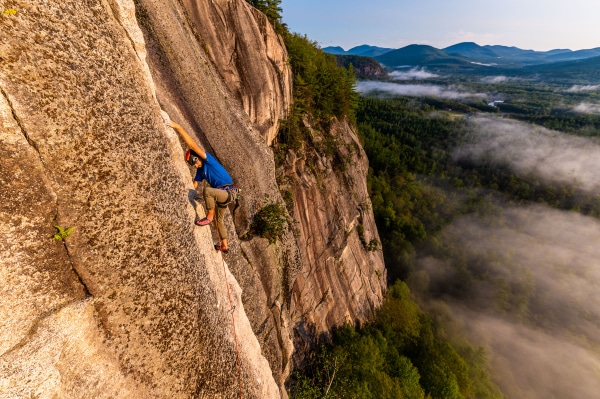Why Cathedral Ledge?
Several weeks ago, a crowd gathered at the base of Cathedral Ledge to discuss the recent addition of bolts at the cliff, ideas of the future for the area, and climbing ethics at large. As ethics conversation tend to go, the night was not without its highs and lows. That said, most of the conversation was respectful and left most with the general impression that the local community still greatly values the traditional style of climbing that a cliff like Cathedral Ledge offers.
There were 60-some climbers in attendance that night (it should be noted that they represented just a small slice of those who climb at the cliff and skewed heavily towards those who live in the immediate area). Notably, of those who were there, nearly all voted in favor of renewing a statement that came out of similar discussions in the early 2000s (some abstained, no one voted “no”). That statement reads, “It is the consensus of this group that an established routes’ original character and integrity be maintained“.

Grant Simmons on the Faux Pas Arete. Photo by Josh Laskin.
Everyone was given a minute and a half to speak their thoughts on the matter and I thought I’d share an extended version of what I read aloud that night (shakily, I might add, as I got a bit choked up and realized that night just exactly what this place means to me).
When we think of making a climb safer, we should first consider our personal abilities to do so. We have our ability to prepare, train, and rehearse; a vast supply of information available to us via the internet, guidebooks, & our fellow community members; and our movement & technical skills that we may use to down climb or retreat from our intended objective.
We should also remember that failure is a part of this sport. And so is the understanding that we won’t always be able to climb every route at the crag. Both of these things teach us humility and patience. They give us reason to work harder for the send and they keep our egos in check as we remember that we are merely human, and that that’s okay.
The climbing on this cliff is not always Type 1 fun. It is often far more adventurous than that and, as a result, I believe it to be far more rewarding. It is a place that requires an investment of time and energy and it can be absolutely unforgiving of being poorly prepared. On the backend, that investment is repaid in spades as we climb truly memorable routes with the people we love and head out on far flung adventures that we are well-prepared for. It is certainly true that not all climbing prepares you for Cathedral Ledge, but on the other hand, spending time here gives you a solid foundation of well-rounded skills and allows you to succeed in so many varied areas around the world.
From my perspective, the uniqueness of this cliff is worth a conservation-based approach. Its style and ethic is a limited resource in the modern climbing era, one that I believe is worth preserving. We should be open to logical and practical solutions to an evolving environment, but we should also make a concerted effort to maintain the traditional character of the cliff for all who may wish to experience it as such.
When we think of retrobolting routes to increase safety, we should be wary of the slippery slope. We should keep in mind the consistently committing climbing that is found across the grade range and the no-fall situations that are common on the cliff’s classic introductory circuit. With such high-stakes moderate routes, there is great opportunity to ease into the style and to take one’s time.
Let us not put our impatient desires to climb hard ahead of our abilities to prepare for a route. Let us not change the cliff to suit our current needs but rather, be patient and be humble.
I oppose the bolted linkup between Airation and Heather.
I oppose the retrobolting of Camber.
These thoughts are mine and mine alone. All are entitled to their own ideas about the cliff. All I have to go on is my own personal experience and growth after my days spent at one of the country’s best crags.
– Grant Simmons


